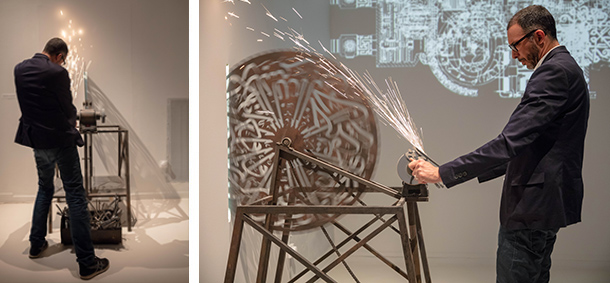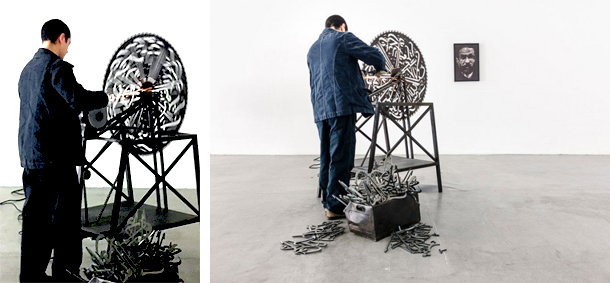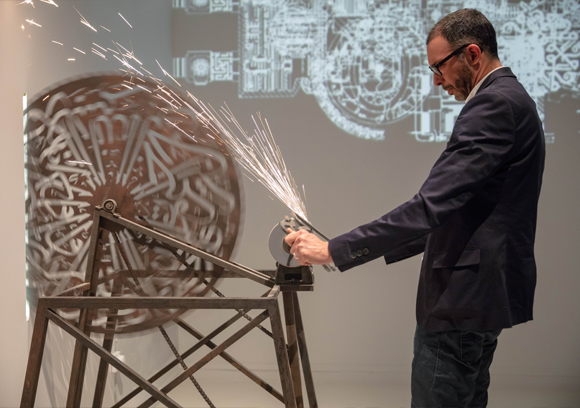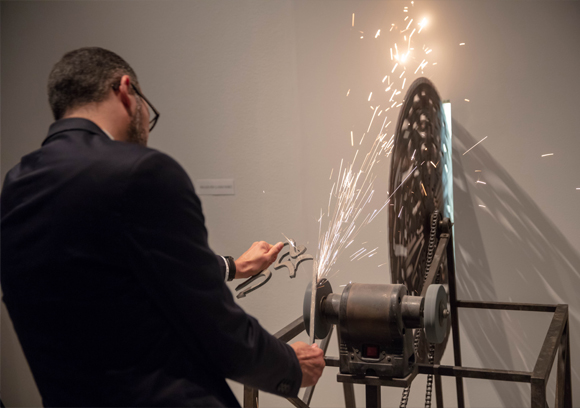| |
|
|
09.
| The Paradox |
| |


2018, The Paradox, Göteborg Konsthall, Göteborg.
Exhibition View from 180° Behind me, Göteborg Konsthall, Göteborg, 2018.
Courtesy of the artist and Ceysson & Bénétière, Paris.

2014, The Paradox, Galerie Yvon Lambert, Paris.
Exhibition view from They were blind, they only saw images, Galerie Yvon Lambert, 2014, Paris.
Courtesy of the artist and Ceysson & Bénétière, Paris.
'' Finally, the work takes on its full meaning only with, and thanks to, man. By sharpening these scraps of calligraphy, the work urges prudence vis-à-vis religious messages.
The machine’s magnetism and aestheticism go hand in hand with its latent, implied threat. ''
Studio Fatmi, January 2014

The Paradox
Exhibition View from 180° Behind me, Göteborg Konsthall, Göteborg, 2018.
Courtesy of the artist and Ceysson & Bénétière, Paris.

The Paradox
Exhibition View from 180° Behind me, Göteborg Konsthall, Göteborg, 2018.
Courtesy of the artist and Ceysson & Bénétière, Paris.
|
|
|
|
|
|
La performance Le Paradoxe est une action qui active une machine à remouler obsolète avec une lame de scie circulaire sur laquelle sont découpées des versets coraniques en langue arabe classique. Louant l’unicité de Dieu dans l’Islam, ces versets dispersés à la surface de la lame s’opposent à la Trinité chrétienne où subsiste une dimension humaine, celle du fils. Des éclats de ce même verset calligraphié sont dispersés autour de la machine, comme échappés de la surface de la lame. Cet effet est accentué lors de la mise en branle de la machine par un performeur, qui tente d’affuter ces bribes de texte sacré et de continuer à alimenter la machine. De ce geste, l’homme décharge le texte symbolisé par ces objets de toute valeur religieuse.
En activant l’œuvre, le performeur exécute une action ancestrale, celle d’affuter et d’aiguiser le fer. Les morceaux de calligraphies, deviennent alors des lames d’une arme blanche. Perdant ainsi son sens, le texte coranique, se disperse et le mouvement tournant de la scie incite à remettre en circulation l’autonomie des idées et des mots. Invitant à réfléchir sur la pérennité doctrinale, la performance le Paradoxe pose la question de la beauté et de la violence de la machine, mais aussi la fascination que cette machine, même obsolète exerce sur l’homme.
Finalement, l’œuvre ne prend réellement tout son sens qu’en présence et grâce à l’homme. En aiguisant ces bribes de calligraphies, l’œuvre exhorte à la prudence vis-à-vis des messages religieux. Le magnétisme produit par le mouvement de la machine et son esthétisme va de pair avec la menace latente qu’elle implique. Ainsi, la manière dont l’homme met en branle cette machine obsolète presque par automatisme, opère un renversement. L’homme devient alors la machine qu’il essaie d’activer.
Studio Fatmi, Janvier 2014.
|
|
The Paradox performance is an action that activates an obsolete remolding machine and a circular saw blade out of which Koranic verses in the classical Arab language are cut. Praising the uniqueness of God in Islam, these verses scattered on the surface of the blade oppose the Christian Trinity as it contains a human element: the son. Shards of the same calligraphic verse are scattered around the machine, as if they had escaped from the surface of the blade. This effect is accentuated when the machine is set in motion by a performer, who tries to sharpen these pieces of text and continues to feed the machine. With this gesture, the man removes any religious value from the texts that are symbolized by this object.
In activating the work, the performer carries out an ancestral gesture: honing and sharpening the iron. The pieces of calligraphy become the blades of a white weapon. Thus losing its meaning, the Koranic text is dispersed and the turning motion of the saw encourages the circulation of autonomous ideas and words. Invoking reflection on doctrinal longevity, the Paradox performance presents the question of the machine’s beauty and violence, but it also presents the fascination that this obsolete machine can conjure up in man.
Finally, the work takes on its full meaning only with, and thanks to, man. By sharpening these scraps of calligraphy, the work urges prudence vis-à-vis religious messages. The machine’s magnetism and aestheticism go hand in hand with its latent, implied threat. The manner in which man sets this machine, nearly made obsolete by automatism, in motion, creates a reversal. Man thus becomes the machine that he tries to operate.
Studio Fatmi, January 2014.
Traduit du français par Christina Whashington. |
|
|
|